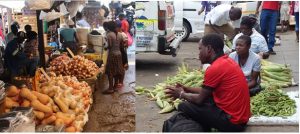As buying patterns signify ordinary people’s priorities, developing countries should invest more in finding pockets of opportunity from micro-markets than pursuing mega deals. In most African countries, much of the overlooked growth is within open food markets from which the majority get food and income. An outside observer may see open markets as chaotic economic but these environments are characterized by order and a distinct buying pattern. For instance, when food vendors get into the market with their baskets early in the morning, they first go for tomatoes, followed by leafy vegetables, then onion. All these are necessities.

Then the buying pattern swings to wild fruits, followed exotic fruits. By then the baskets are becoming heavy but the buying process is not over until lemon, avocadoes, banana and cooked dried groundnut are picked from one of the two farmers’ markets where apples are also picked. The basket is then taken to the Matatu/Kombi station before buying route goes to oranges and then cabbages. If the budget is still not exhausted, the buyer goes to the dry retail markets to pick Maputi, matemba, soya chunks and Madora to complete the food basket.
Prices are also determined by the buying pattern
Besides communicating buyers’ priorities, the buying pattern also sets prices for most commodities especially when vendors get into the market in huge volumes. Buyers who come in individually may not know and own the buying price. The buying pattern also shows how the farmers market brings together demand and builds it outside the market before opening. By the time the market is opened, demand will have already been consolidated as people from different areas congregate at the market. At a given day, 400 to 500 vendors flow into the market and, as mentioned above, they start with buying tomatoes before moving to leafy vegetables. The previous day’s prices influence the amount of money or budget brought to the market each day. Impulse buying is kept to a minimum. If the vendor finds a Sandak of tomatoes going for $80 instead of $75, she forgoes other commodities which may not be necessities. To avoid risks associated with introducing a new commodity to permanent consumers, vendors concentrate on what they know to be on demand.
Emerging characteristics of the market
While social class and income also tends to determine pricing of commodities, the evolving customer classification in open markets comprises the following:
- Walk-in customers who come into the market where there are options to buy straight from the farmers’ market or from wholesale traders.
- Wholesale markets in which bulk is broken and commodities are properly graded.
- Vendors from high density residential areas who have market stalls where they live.
- Road side traders and vendors – some with trucks loaded with fruits and vegetables.
- Push-cart traders moving around selling vegetables and fruits.
- Food basket packers – this group is increasing and comprise small food distributors.
Benefits of staying informed about buying patterns
Staying connected with buying patterns is critical in understanding how prices are set when buyers congregate around commodities in ways that influence competition between different commodities. More than 60% of the pricing is set when commodities come together in one big market. Other benefits of being constantly informed by buying patterns include improved knowledge sharing. For instance, when one buyer asks a question everyone available benefits from the answers provided. Relationships are also built intuitively in the market as buyers move together from one commodity to another, leading to decision for collective purchasing and then sharing, increasing affordability.
Smart decision-making is also cultivated. Buyers learn a lot from the behavior of other buyers through the price negotiation process. On the other hand, it is difficult for a single buyer to benefit from mob or collective price setting techniques. Buying patterns also classify commodities through ways in which markets classify all commodities and determine how they are arranged in the market as well as how measurements are arranged into areas for Sasekas, buckets and numbering (counting). This is critical for minimizing confusion and chaos. Slow moving commodities also have their buying pattern and often their prices can stay the same for up to a month while horticulture commodity prices change daily, calling for dynamic pricing.
For planners, making sense of buying patterns simplifies decisions on how to set up market spaces according to commodities. Farmers, planners and nutritionists also need to be aware of these critical issues. Although open markets continue to carve a unique identity in the global economy, the demand for exotic high value horticulture commodities continue to be largely influenced by up-market consumers. Others sources of influence include events like weddings, parties and catering as a service. Catering service providers have been trained in the English way of preparing meals, incorporating exotic vegetables. Very few indigenous vegetables and fruits are finding their way into the catering curricular, thus spreading their nutritional benefits.
Charles@knowledgetransafrica.com / charles@emkambo.co.zw / info@knowledgetransafrica.com
Website: www.emkambo.co.zw / www.knowledgetransafrica.com
Mobile: 0772 137 717/ 0774 430 309/ 0712 737 430
